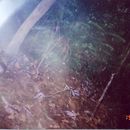en
names in breadcrumbs


Female lesser Malay mouse deer have the potential to be pregnant throughout their adult life, being able to conceive only 85-155 minutes after giving birth (Grzimck, 1994).
Perception Channels: tactile ; chemical
The mouse deer population is threatened by hunting and habitat destruction.
One method to prevent the extinction of mouse deer is captive breeding. This is done primarily in zoos (Jinaka, 1995).
US Federal List: no special status
CITES: no special status
IUCN Red List of Threatened Species: least concern
Mouse deer are hunted for their skins. The pelage of mouse deer is smooth and the skin is used to make handbags and coats (Jinaka, 1995).
T. javanicus is a ruminant and has a three-chambered stomach (Lawlor, 1979). As ruminants, mouse deer use microorganisms that produce enzymes within the stomach to digest their food. In the wild, lesser Malayan mouse deer are commonly herbivores and folivores, eating leaves, buds, shrubs, and fruits that have fallen from trees. In zoos, mouse deer tend to eat insects as well as leaves and fruits (Nowak and Paradiso, 1983).
Tropical forest region in Southeast Asia
Biogeographic Regions: oriental (Native )
Tragulus javanicus are found in overgrown primary and secondary forests in southeast Asia. They often reside around rocks, hollow trees, and dense vegetation near water.
Habitat Regions: tropical ; terrestrial
Terrestrial Biomes: rainforest
Average lifespan
Status: captivity: 12.0 years.
Tragulus javanicus, or lesser Malay mouse deer, do not have antlers or horns. Instead, adult males have elongated, tusk-like upper canines (Nowak and Paradiso, 1983). These canines protrude from the side of the mouth. Females lack these canines. Females are also smaller than the males (Nowak and Paradiso, 1983). The cheekteeth of lesser mouse deer have a crescent pattern formed by the enamel ridges. Mouse deer have no upper incisors. The pelage of mouse deer is brown with an orange tint. The underside is white. There is also a series of white vertical markings on the neck (Grzimck, 1994). Malay mouse deer have a triangular head and a round body with elevated rear quarters. The thin legs are about the diameter of a pencil (Nowak and Parasido, 1983). T. javanicus is the smallest artiodactyl, 18-22 inches long with a tail length of 2 inches (Grzimck, 1994). The young look like miniature adults when born; however, the tusk-like incisors in the infant males are not well developed.
Range mass: 1 to 2 kg.
Other Physical Features: endothermic ; homoiothermic; bilateral symmetry
Sexual Dimorphism: male larger
Average basal metabolic rate: 4.883 W.
Mouse deer can breed at any time of the year. The gestation period is usually 4 1/2 months. Breeding females produce one fawn (Jinaka, 1995). The young are precocial when born and can stand within 30 minutes of birth (Grzimck, 1994). Mouse deer are shy and their fawns tend to be "hiders". The fawn is weaned for 10-13 weeks. It reaches sexual maturity at about 5-6 months. Lesser Malay mouse deer can live for 12 years.
Key Reproductive Features: gonochoric/gonochoristic/dioecious (sexes separate); sexual
Average birth mass: 370 g.
Average gestation period: 144 days.
Average number of offspring: 1.
Average age at sexual or reproductive maturity (male)
Sex: male: 167 days.
Average age at sexual or reproductive maturity (female)
Sex: female: 167 days.